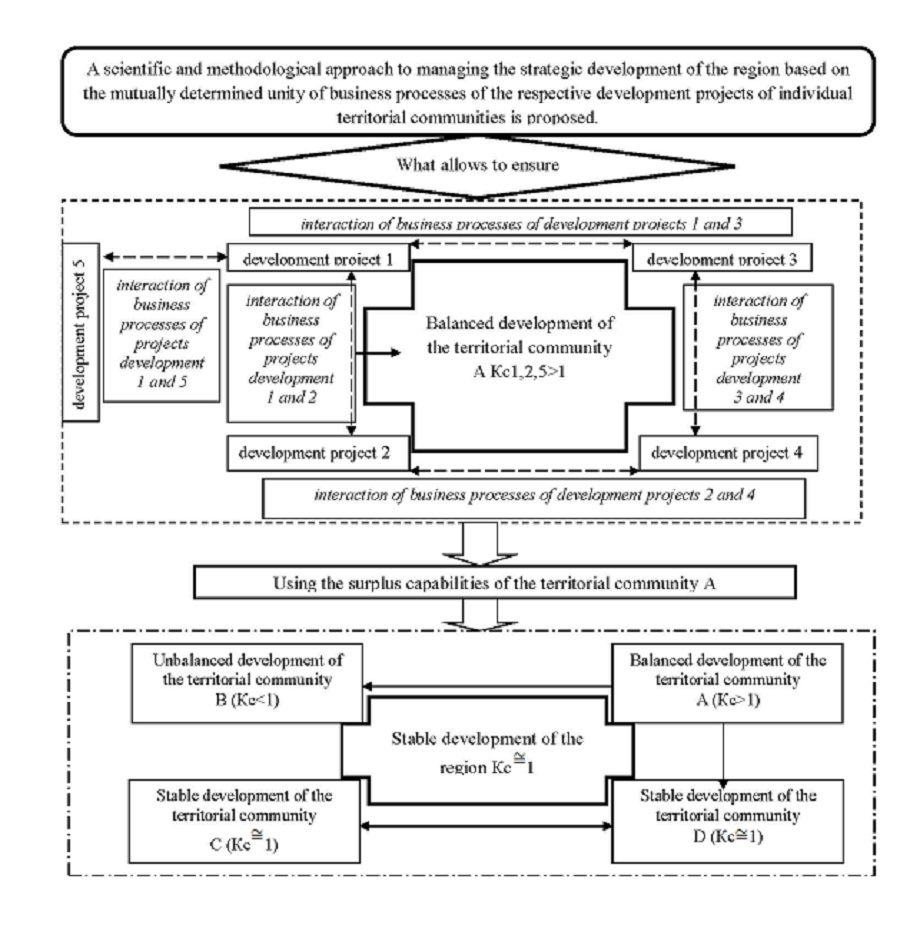Ensuring sustainable development of a region in the strategic period
DOI:
https://doi.org/10.15587/1729-4061.2023.285418Keywords:
sustainable development, territorial community, development projects, business processes, integral indicator of synchronicityAbstract
The stability of the region's development, like any system, depends on the effective balance of its subsystems. The effectiveness of subsystems is enhanced by the effective performance of a set of their key components, which depends on the optimization of certain elements by establishing rational relationships between them. Accordingly, the object of the study is the process of rationalization of the constituent elements of territorial community development programs. To solve this issue, a methodical approach to determining the level of development of the region and ensuring its stability in the strategic period is proposed through the rationalization of the effects of mutually determined implementation of business processes of alternative development projects of territorial communities. The expediency of using the coefficient of synchronicity of business processes of certain regional development projects to determine the level of regional development was substantiated. The use of the synchronicity coefficient to ensure the stable development of the respective region is due to the obtained possibility of balancing the specific competitive advantages of territorial communities strengthened by certain effects. These effects are the results of the implementation of optimally formed portfolios of development projects through rational relationships between specific business processes based on the principle of maximum adaptability of their components. The value of the coefficient of synchronicity of the business processes of the portfolio of development projects of Zabolottivsʹka UTC (0.637) made it necessary to take possible measures for their rationalization by implementing individual effects from the interaction of specific business processes. That has made it possible to increase the synchronicity of these business processes to 0.816 and to determine the direction of the possible integration of the studied UTC with other communities with the help of the formed development potential reserves
References
- Davydenko, N., Dibrova, A., Onishko, S., Fedoryshyna, L. (2021). The Influence Of The Gross Regional Product On The Formation Of The Financial Potential Of The Region. Journal of Optimization in Industrial Engineering, 14 (1), 153–157. doi: https://doi.org/10.22094/JOIE.2020.677843
- Bienvenido-Huertas, D., Farinha, F., Oliveira, M. J., Silva, E. M. J., Lança, R. (2020). Comparison of artificial intelligence algorithms to estimate sustainability indicators. Sustainable Cities and Society, 63, 102430. doi: https://doi.org/10.1016/j.scs.2020.102430
- Triki, R., Maâloul, M. H., Bahou, Y., Kadria, M. (2023). The Impact of Digitization to Ensure Competitiveness of the Ha’il Region to Achieve Sustainable Development Goals. Sustainability, 15 (2), 1661. doi: https://doi.org/10.3390/su15021661
- Ramos, T. B. (2009). Development of regional sustainability indicators and the role of academia in this process: the Portuguese practice. Journal of Cleaner Production, 17 (12), 1101–1115. doi: https://doi.org/10.1016/j.jclepro.2009.02.024
- Palekhov, D., Palekhova, L. (2016). Conceptual framework for balancing economic growth and environmental sustainability at regional level. Naukovyi visnyk NHU, 1, 148–152. Available at: https://nvngu.in.ua/index.php/en/component/jdownloads/finish/56-05/8411-2015-05-palekhov/0
- Kozyk, V., Liutak, O., Lisovska, L., Mrykhina, O., Novakivskyj, I. (2021). The impact of economic entities’ innovative activity on the indicators of sustainable development of Ukraine. IOP Conference Series: Earth and Environmental Science, 628 (1), 012041. doi: https://doi.org/10.1088/1755-1315/628/1/012041
- Abreu, I., Mesias, F. J. (2020). The assessment of rural development: Identification of an applicable set of indicators through a Delphi approach. Journal of Rural Studies, 80, 578–585. doi: https://doi.org/10.1016/j.jrurstud.2020.10.045
- Zabolottivska terytorialna hromada. Available at: https://decentralization.gov.ua/newgromada/3576
- Chervonohradska miska rada. Available at: https://www.chg.gov.ua
- Horodotska terytorialna hromada. Available at: http://horodok-rada.gov.ua/node/12443
- Zalutska, K., Protsenko, V., Maslak, T. (2023). Organizing effective competitive development of enterprises through the formation of a rational base of resource provision: methodological aspect. Eastern-European Journal of Enterprise Technologies, 1 (13 (121)), 6–17. doi: https://doi.org/10.15587/1729-4061.2023.273783
- Zalutska, K., Petrushka, K., Myshchyshyn, O., Danylovych, O. (2021). Strategic management of the innovative activity of the enterprise. Journal of Optimization in Industrial Engineering, 14 (1), 95–103. doi: https://doi.org/10.22094/joie.2020.677838

Downloads
Published
How to Cite
Issue
Section
License
Copyright (c) 2023 Viktoriia Prokhorova, Khrystyna Zalutska, Yuliia Fedorova, Tetiana Obydiennova, Oksana Prykhodchenko

This work is licensed under a Creative Commons Attribution 4.0 International License.
The consolidation and conditions for the transfer of copyright (identification of authorship) is carried out in the License Agreement. In particular, the authors reserve the right to the authorship of their manuscript and transfer the first publication of this work to the journal under the terms of the Creative Commons CC BY license. At the same time, they have the right to conclude on their own additional agreements concerning the non-exclusive distribution of the work in the form in which it was published by this journal, but provided that the link to the first publication of the article in this journal is preserved.
A license agreement is a document in which the author warrants that he/she owns all copyright for the work (manuscript, article, etc.).
The authors, signing the License Agreement with TECHNOLOGY CENTER PC, have all rights to the further use of their work, provided that they link to our edition in which the work was published.
According to the terms of the License Agreement, the Publisher TECHNOLOGY CENTER PC does not take away your copyrights and receives permission from the authors to use and dissemination of the publication through the world's scientific resources (own electronic resources, scientometric databases, repositories, libraries, etc.).
In the absence of a signed License Agreement or in the absence of this agreement of identifiers allowing to identify the identity of the author, the editors have no right to work with the manuscript.
It is important to remember that there is another type of agreement between authors and publishers – when copyright is transferred from the authors to the publisher. In this case, the authors lose ownership of their work and may not use it in any way.









